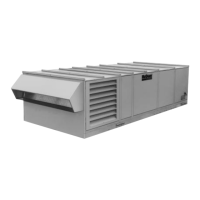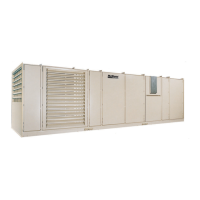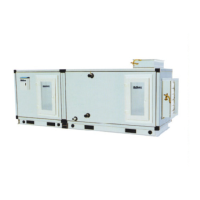IM-738 Page 35
Piping Recommendations
1. Use type K or L clean copper tubing. All joints should be
thoroughly cleaned or brazed with high temperature solder.
2. Piping sizes should be based on temperature/pressure lim-
itations as recommended in the following paragraphs.
Under no circumstances should pipe size be based strictly
upon coil or condensing unit piping connection size.
3. Suction line piping pressure drop should not exceed the
pressure equivalent of 2°F (1°C), 3 psi (20.7 kPa) per 100
feet (30.5 m) of equivalent pipe length. After the suction
line size has been determined, the vertical suction risers
should be checked to verify that oil will be carried up the
riser and back to the compressor. The suction line(s) should
be pitched in the direction of refrigerant flow and ade-
quately supported. Lines should be free draining and fully
insulated between the evaporator and the compressor.
4. Vertical suction risers should be checked using Table 9 on
page 35 to determine the minimum tonnage required to
carry oil up suction risers of various sizes.
5. The liquid line should be sized for a pressure drop not
to exceed the pressure equivalent of 2°F (1°C), 6 psi
(41.4 kPa) saturated temperature. The RFS unit
includes a factory installed filter-drier, solenoid valve,
and sightglass in each liquid line, upstream of the ther-
mostatic expansion valve.
Table 9: Minimum tonnage (R-22) to carry oil up suction
riser at 40°F saturated suction
Holding Charge
The RFS unit and RCS unit ship with a nitrogen holding
charge. At the time the unit was received, a visual inspection
of the unit piping should have been made to be sure no break-
age had occurred or that the fittings had not loosened. A pres-
sure test on the RCS units should indicate a positive pressure
in the unit. If no pressure is evident, the unit will have to be
leak tested and the leak repaired. This should be noted and
reported to the McQuay sales representative and freight car-
rier if the loss is due to shipping damage.
The RFS unit does not have gauge ports for pressure mea-
surement. If no positive pressure is detected when cutting off
the process tubes and removing the tubing caps, the unit
should be leak tested as described above, after the intercon-
necting piping has been brazed in place. This test will also
confirm the integrity of the field braze joints.
Leak Testing
In the case of loss of the nitrogen holding charge, the unit
should be checked for leaks prior to charging the complete
system. If the full charge was lost, leak testing can be
done by charging the refrigerant into the unit to build the
pressure to approximately 10 psig and adding sufficient
dry nitrogen to bring the pressure to a maximum of 125
psig. The unit should then be leak tested with halide or
electronic leak detector. After making any necessary
repair, the system should be evacuated as described in the
following paragraphs.
Evacuation
After it has been determined that the unit is tight and there
are no refrigerant leaks, the system should be evacuated.
The use of a vacuum pump with a pumping capacity of
approximately 3 cu.ft./min. and the ability to reduce the
vacuum in the unit to at least 1 millimeter (1000 microns)
is recommended.
1. A mercury manometer or an electronic or other type of
micron gauge should be connected to the unit at a point
remote from the vacuum pump. For readings below 1 milli-
meter, an electronic or other micron gauge should be used.
2. The triple evacuation method is recommended and is par-
ticularly helpful if the vacuum pump is unable to obtain
the desired 1 millimeter of vacuum. The system is first
evacuated to approximately 29" (740 mm) of mercury.
Enough refrigerant vapor is then added to the system to
bring the pressure up to 0 pounds (0 microns).
3. Then the system is once again evacuated to 29" (740 mm)
of vacuum. This procedure is repeated three times. This
method can be most effective by holding system pressure
at 0 pounds (0 microns) for a minimum of 1 hour between
evacuations. The first pulldown will remove about 90% of
the noncondensables, the second about 90% of that
remaining from the first pulldown, after the third, only 1/
10 of 1% of noncondensables will remain.
Table 13 on page 37 shows the relationship between pres-
sure, microns, atmospheres, and the boiling point of water.
LINE SIZE
O.D.
1-1/8" 1-3/8" 1-5/8" 2-1/8" 2-5/8" 3-1/8" 3-5/8" 4-1/8"
MIN.
TONES
1.5 2.5 3.8 7.6 13.10 20.4 29.7 41.3
WARNING
Always vent piping to atmosphere before applying heat to
removed brazed piping caps and plugs. Failure to do so
could result in hazardous pressures within the refrigerant
circuit, possibly resulting in a dangerous explosion.
RCS - Vent to atmosphere by opening gauge ports at
the compressors and liquid line shutoff valves. Make
sure manual valves are not back seated to shut off the
gauge ports.
RFS - Vent to atmosphere by cutting off the process
tubes on the suction line caps.
WARNING
Do not use oxygen to build up pressure.
A serious explosion could result from using oxygen to build
up pressure, resulting in severe personal injury or death.

